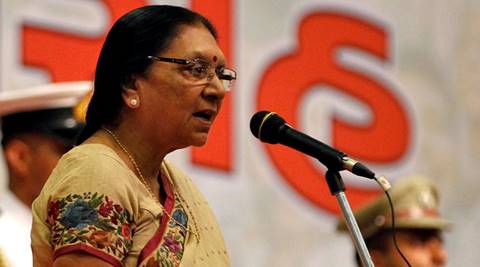Opinion This day, in Gujarat
Anandiben Patel’s resignation brings home the BJP’s political challenge in a long-time bastion. Its next steps will be watched.

The resignation of Anandiben Patel as chief minister of Gujarat is an arresting political moment. Not many will believe the reason Patel herself has offered for her decision — that she is nearly 75 years old and is, in the best tradition of her party, making way for a younger leadership ahead of next year’s assembly polls. The fact is, Patel was chosen by Narendra Modi to rule in his place, when he became prime minister more than two years ago, and she has visibly struggled to make the fit. She has unsuccessfully contended with factional intrigue within the party and has presided over the eruption of popular movements of discontent in a state where the BJP has enjoyed unbroken dominance since the mid 1990s, even as the main opposition, the Congress, remains steeped in somnolence. Patel’s stepping down now and its aftermath is significant for Gujarat, but it resonates outside it too. Gujarat, after all, is a state that casts a long shadow on the national political imagination ever since it was energetically promoted and projected by the Modi-led BJP as a “model” for the nation in the 2014 Lok Sabha campaign.
Patel’s resignation outlines the political challenge for the BJP in a bastion, where for long, Modi’s persona and cult had overtaken and overwhelmed politics as usual. For many years, there was no major stirring against the ruling regime. That story has changed after his move to national politics. Over the last few months, the government has been pushed on to the backfoot by at least two gathering discontents — first the uprising of the Patels, the dominant community which has traditionally supported the BJP, on the issue of reservations, and after that, by the strong Dalit protests against the flogging of a family by gau rakshaks for skinning a dead cow in Una.
WATCH VIDEO: Who Will Replace Anandiben Patel: BJP Parliamentary Board To Decide Soon
Their anatomy may vary, but essentially, both agitations articulate the resentments of those who feel bypassed by, or excluded from, the Gujarat model of development. If on the one hand, the relatively well-off Patels press their demands on the state in a time of shrinking economic opportunity for small and medium enterprise, the historically marginalised groups, the Dalits, are reminding the state that it has failed them too. In the wake of Anandiben’s exit, therefore, the BJP must grapple with a leadership challenge and also a deeper questioning of its political and economic policy in Gujarat.
How the BJP addresses this volatility in what seemed till recently a stable stronghold will be watched. Its next steps in Gujarat will impact the elections to be held in that state next year. They could also affect its poise and gait in other electoral arenas, including Uttar Pradesh.





